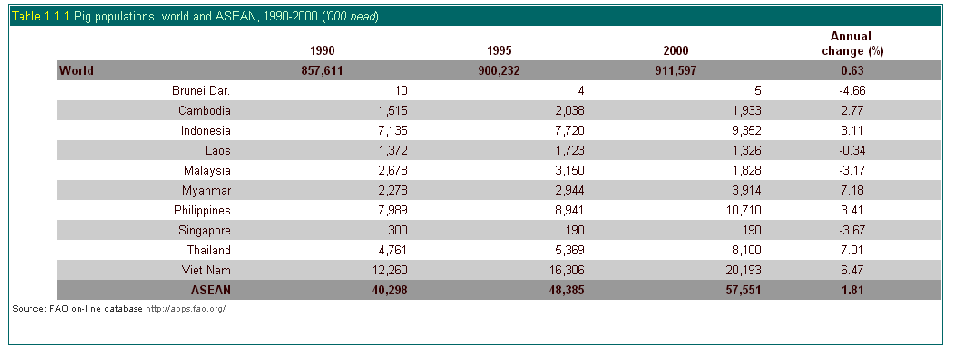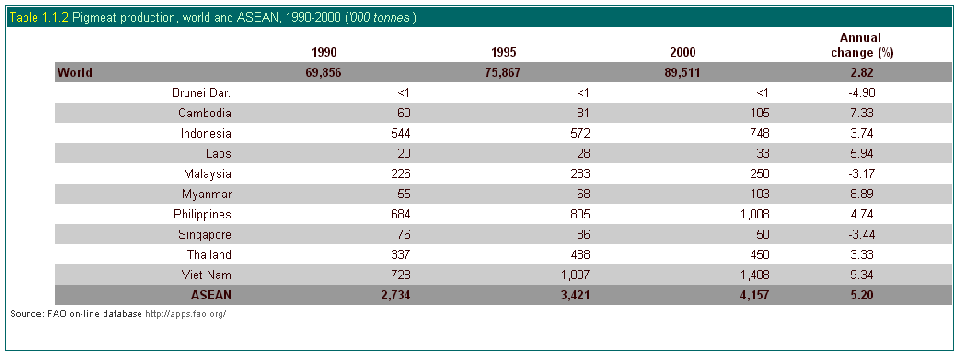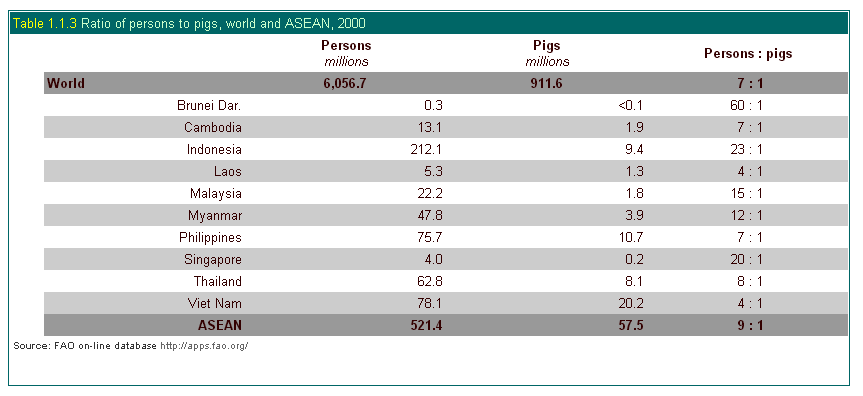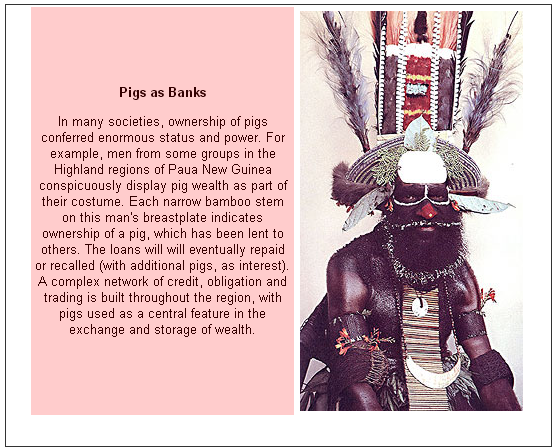


Raise A Pig
1.1.3 WHY DO PEOPLE RAISE PIGS?
1.1.3.1 Statistics
Pigs are an important part of many people's lives. They are one of the most common and numerous of the domesticated farm animal species, throughout the world. Three tables below summarize the estimated national populations and production of pig meat in the ASEAN region. In Table 1.1.3, the ratio of people to pigs is listed (national human population : national pig population). This shows how the importance of pigs will vary between countries. Most of these variations relate to different social and cultural values, and dietary preferences.



1.1.3.2 Importance
Pigs meet a number of requirements which are important to human society. The original ancestors of pigs were wild animals, which would have been hunted by people for food. Over time, some people realized that - rather than hunting the pigs - it might be easier to catch them and keep them, to be slaughtered when needed. Other groups of people learned from these successes: they might have traded for some pigs or caught and raised wild ones.
Many other types of wild animal were gradually caught and domesticated, each meeting a variety of purposes. Most are very familiar to us, for example:
- Cattle and buffalo (milk, meat, leather, power)
- Elephants (power, transport, fighting)
- Camels (transport, power, milk, hair)
- Horses and ponies (transport, power, meat and milk)
- Sheep and goats (milk, meat, wool and hair)
- Chickens and ducks (eggs, meat, feathers)
- Dogs (Hunting, protection, companionship)
- Cats (pest control, companionship)
- Birds (song, beauty, companionship)
- Fish and shrimps (food)
Pigs have become "successfully integrated" with human life because they fill a wide variety of needs. Their spread throughout the world comes partly through their association with humans. People explored the world by foot or boat. Frequently they carried pigs with them, together with other domesticated animals, plant seeds and cuttings. As people established themselves in new lands, they raised the plants and animals they had brought with them and also experimented with new species they discovered. Species which proved useful and reliable were kept and developed; others were tried and discarded. The fact that pigs have been maintained as a domestic specie for so long indicates their valuable integration with human life and survival. Characteristics which contribute to this resilience include:
Adaptability
Food
Versatility
Trade and income
Wealth
Social and cultural aspects
Adaptability
Pigs are one of the most adaptable of animal species. Being omnivorous, they can select from a wide range of feed types; they are also intelligent and naturally curious. Together these two factors combine to increase the probability of pigs surviving in new physical environments: they actively explore their surroundings and try new types of food. If necessary, pigs will aggressively defend their territory against competitors and predators. They are fertile and reproduce quite quickly, ensuring the release of new generations of piglets after establishment and the long-term survival of the species in the new environment. All such characteristics were well understood by their owners: carrying pigs was a good investment of time and resources.
Traditionally, most pigs were raised as scavengers in small, mixed-farming system. They may have been tethered or enclosed at night for safety but wandered relatively freely during the day. During this time they would forage or dig for food. They grew slowly but were resilient and survived well. Farmers had to devote little time to the maintenance or management of pigs, other than herding them and preventing loss through predators or theft. All these attributes met the requirements of human communities, which had to devote time to a great number of other activities to ensure the welfare and safety of their families.
Food
Pork is a tasty, nourishing meat. In addition, pigs can also produce substantial quantities of fat. Fat is a dense high-value store of energy. It also makes meat more palatable and tasty. Although fat is a less popular component of the human diet in some modern societies, it used to be a highly-prized food and was often considered more valuable than muscle.
Versatility
The pig has many attributes of value to human society. Most parts of the carcass can be consumed or processed as human food; the skin can be eaten or used as leather; the hair is used for brushes or fiber. The development of processing techniques such as curing, smoking and fermentation led to a great expansion of food products. These extended the storage life of meat, increased the variety of flavors and enhanced the human diet.
The pig will eat wastes and other material that cannot be consumed by ruminant animals (such as cattle or sheep) and humans; its manure is applied as crop fertilizer.
Trade, income and wealth
The domesticated pig soon became a valuable item of trade. Long before money was invented, people would have bartered pigs (and many other things), trading live pigs or pork for goods produced by other people. Trading meant that the pig gained economic values.
The sale of pigs and products now provides a source of income for millions of farm families. There has also been an expansion in business activities which depend upon the production of pigs: trade, transport, marketing, abattoirs, food processors and many more. To these must be added the suppliers of inputs to the industry such as the manufacturers of pig feeds, producers of specialist breeding animals and semen, veterinary suppliers, buildings and equipment.
As pigs have an economic value, live pigs are a form of savings for their owner. They are a store of wealth, to be sold when market conditions are appropriate or the household needs income urgently. In many societies, the storage of wealth was often more important than the value of the animal as food. A large herd of pigs meant some insurance against future uncertainty, converting immediate production (eg, the harvesting of crops) into a long-term investment.
Social and cultural aspects
Pigs have been given a status which well exceeds their value as food or income. Pigs have been a part of human society for so long they have become intrinsic to many cultures. They are celebrated in songs, stories and poems; pictures are painted, books published and carvings made. Pigs are given human personalities. They are made into heroes or villains in moral fables and legend. Their intelligence is recognized and applauded in some societies; in others, they are vilified as dirty and degenerate. People keep them as pets and take them for walks. Their by-products (e.g., tusks and bones) are prized for decoration. In some societies, the number of pigs owned is a direct indicator of social status. They are used as a basis for indigenous credit and investment systems among some communities.

fREFERENCESAnimal Diversity Web (ADW)
Museum of Zoology, University of Michigan.
http://animaldiversity.ummz.umich.edu/chordata/mammalia/artiodactyla.html
Lawrence, E. (1989)
Henderson's Dictionary of Scientific Terms. Longman Group Ltd, Burnt Mill, Harlow, Essex, England
Nowak, R.M. (1991)
Walker's Mammals of the World (Fifth Edition). The Johns Hopkins University Press, Baltimore. (http://www.press.jhu.edu/books/walker/artiodactyla.suidae.html)
Oliver, W.L.R. (1993)
Pigs, Peccaries, and Hippos. International Union for Conservation of Nature and Natural Resources (IUCN): Gland, Switzerland.
Savage, R.J.G. and Long, M.R. (1986)
Mammal Evolution, an Illustrated Guide. Facts of File Publications, New York.
The Ultimate Ungulate Page: Your Guide to the World's Hoofed Mammal Species. http://www.ultimateungulate.com/artiodactyla.html